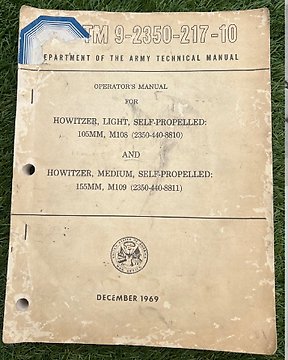
United States of America - US Army Vietnam War Manual M108 / M109 Self Propelled Gun 155mm - 1969
Nº 84195853

Nº 84195853

Rare difficult to find and official classified US Army Manual for the famous ''Honest John Rocket Launcher system'', an absolute icon of the cold war, dated 1969, with 100's of pages of technical information about the missiles, technique, packaging, etc! Highly illustrated and overall a great manual, complete with a part of the supplementary changes (these supposed to be loose leaflets).
A must-have for the US Vietnam / Cold War collector, great and difficult to find manual!
See also our other interesting WW2 items that we offer for auction on catawiki!
HIstory of the Honest John Rocket Launcher System
The MGR-1 Honest John rocket was the first nuclear-capable surface-to-surface rocket in the United States arsenal.[notes 1] Originally designated Artillery Rocket XM31, the first unit was tested on 29 June 1951, with the first production rounds delivered in January 1953. Its designation was changed to M31 in September 1953. The first Army units received their rockets by year's end and Honest John battalions were deployed in Europe in early 1954. Alternatively, the rocket was capable of carrying an ordinary high-explosive warhead weighing 1,500 pounds (680 kg).
Developed at Redstone Arsenal, Alabama, the Honest John was a large but simple fin-stabilized, unguided artillery rocket weighing 5,820 pounds (2,640 kg) in its initial M31 nuclear-armed version. Mounted on the back of a truck, the rocket was aimed in much the same way as a cannon and then fired up an elevated ramp, igniting four small spin rockets as it cleared the end of the ramp. The M31 had a range of 15.4 miles (24.8 km) with a 20 kiloton nuclear warhead and was also capable of carrying a 1,500-pound (680 kg) conventional warhead.
The M31 system included a truck-mounted, unguided, solid-fueled rocket transported in three separate parts. The Honest John was assembled in the field before launch, mounted on an M289 launcher, and aimed and fired in about 5 minutes. The rocket was originally outfitted with a W7 nuclear warhead, with a variable yield of up to 20 kilotons of TNT (84 TJ); in 1959, a W31 warhead with three variants was deployed with yields of 2, 10 or 30 kt (8.4, 41.8 or 125.5 TJ). There was a W31 variant of 20 kt (84 TJ) used exclusively for the Nike Hercules anti-aircraft system. The M31 had a range between 3.4 and 15.4 mi (5.5 and 24.8 km).
Early tests exhibited more scatter on target than was acceptable when carrying conventional payloads. Development of an upgraded Honest John, M50, was undertaken to improve accuracy and extend range. The size of the fins was greatly reduced to eliminate weathercocking. Increased spin was applied to restore the positive stability margin that was lost when fin size was reduced. The improved M50, with the smaller fins and more "rifling", had a maximum range of 30+ miles with a scatter on target of only 250 yards (230 m), demonstrating an accuracy approaching that of tube artillery. The Honest John was manufactured by the Douglas Aircraft Company of Santa Monica, California.[3]
In the 1960s, sarin nerve gas cluster munitions were also available, designed to be interchangeable for use with either the Honest John or MGM-5 Corporal. Initially the M79 (E19R1) GB cluster warhead, containing 356 M134 (E130R1) bomblets for the M31A1C Honest John. The production model was the M190 (E19R2) GB cluster warhead, containing 356 M139 (E130R2) bomblets when the M31A1C was phased out in favor of the XM50 Honest John. Under nominal conditions it had an mean area of effect of 0.9 square kilometers.[4]
Comment acheter sur Catawiki ?
1. Découvrez des objets d’exception
2. Faites la meilleure offre
3. Effectuez un paiement sécurisé